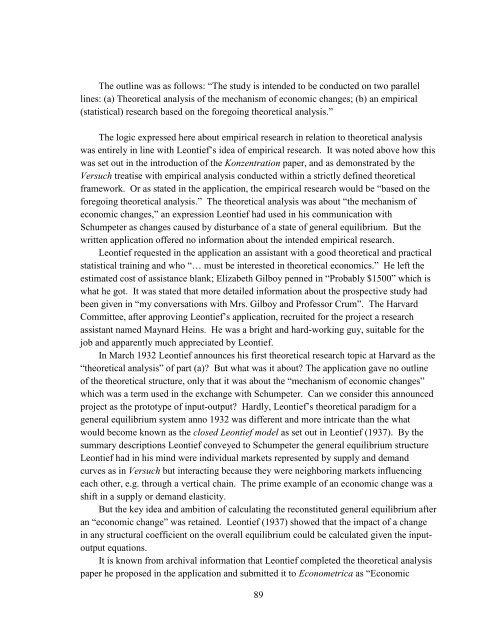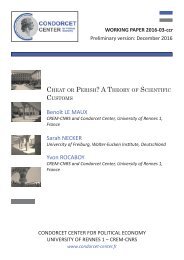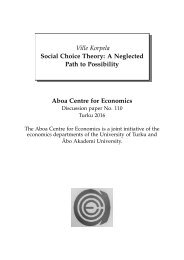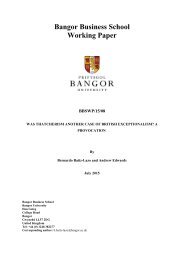MEMORANDUM
n?u=RePEc:hhs:osloec:2016_018&r=hpe
n?u=RePEc:hhs:osloec:2016_018&r=hpe
Create successful ePaper yourself
Turn your PDF publications into a flip-book with our unique Google optimized e-Paper software.
The outline was as follows: “The study is intended to be conducted on two parallel<br />
lines: (a) Theoretical analysis of the mechanism of economic changes; (b) an empirical<br />
(statistical) research based on the foregoing theoretical analysis.”<br />
The logic expressed here about empirical research in relation to theoretical analysis<br />
was entirely in line with Leontief’s idea of empirical research. It was noted above how this<br />
was set out in the introduction of the Konzentration paper, and as demonstrated by the<br />
Versuch treatise with empirical analysis conducted within a strictly defined theoretical<br />
framework. Or as stated in the application, the empirical research would be “based on the<br />
foregoing theoretical analysis.” The theoretical analysis was about “the mechanism of<br />
economic changes,” an expression Leontief had used in his communication with<br />
Schumpeter as changes caused by disturbance of a state of general equilibrium. But the<br />
written application offered no information about the intended empirical research.<br />
Leontief requested in the application an assistant with a good theoretical and practical<br />
statistical training and who “… must be interested in theoretical economics.” He left the<br />
estimated cost of assistance blank; Elizabeth Gilboy penned in “Probably $1500” which is<br />
what he got. It was stated that more detailed information about the prospective study had<br />
been given in “my conversations with Mrs. Gilboy and Professor Crum”. The Harvard<br />
Committee, after approving Leontief’s application, recruited for the project a research<br />
assistant named Maynard Heins. He was a bright and hard-working guy, suitable for the<br />
job and apparently much appreciated by Leontief.<br />
In March 1932 Leontief announces his first theoretical research topic at Harvard as the<br />
“theoretical analysis” of part (a)? But what was it about? The application gave no outline<br />
of the theoretical structure, only that it was about the “mechanism of economic changes”<br />
which was a term used in the exchange with Schumpeter. Can we consider this announced<br />
project as the prototype of input-output? Hardly, Leontief’s theoretical paradigm for a<br />
general equilibrium system anno 1932 was different and more intricate than the what<br />
would become known as the closed Leontief model as set out in Leontief (1937). By the<br />
summary descriptions Leontief conveyed to Schumpeter the general equilibrium structure<br />
Leontief had in his mind were individual markets represented by supply and demand<br />
curves as in Versuch but interacting because they were neighboring markets influencing<br />
each other, e.g. through a vertical chain. The prime example of an economic change was a<br />
shift in a supply or demand elasticity.<br />
But the key idea and ambition of calculating the reconstituted general equilibrium after<br />
an “economic change” was retained. Leontief (1937) showed that the impact of a change<br />
in any structural coefficient on the overall equilibrium could be calculated given the inputoutput<br />
equations.<br />
It is known from archival information that Leontief completed the theoretical analysis<br />
paper he proposed in the application and submitted it to Econometrica as “Economic<br />
89





